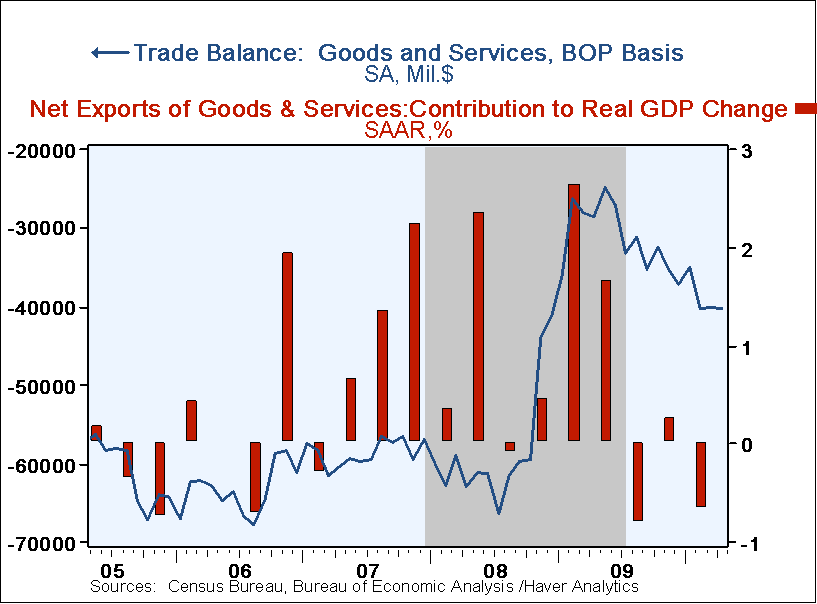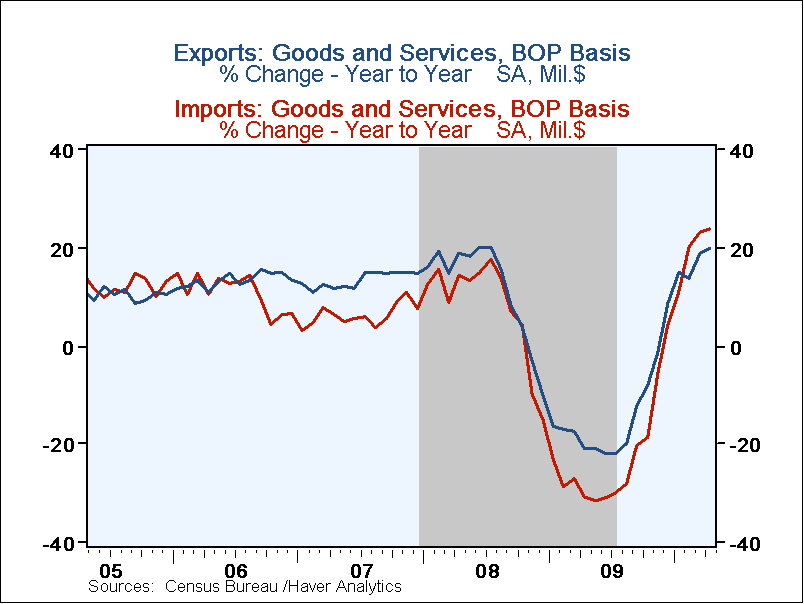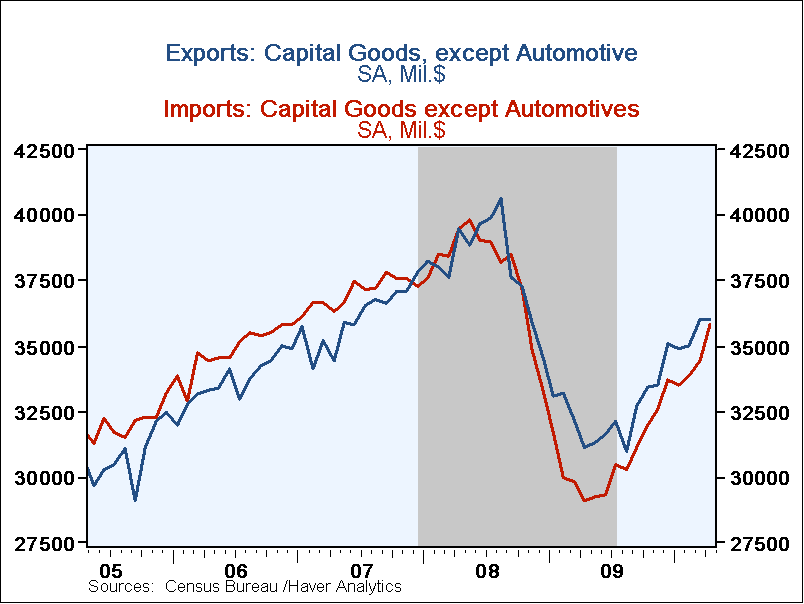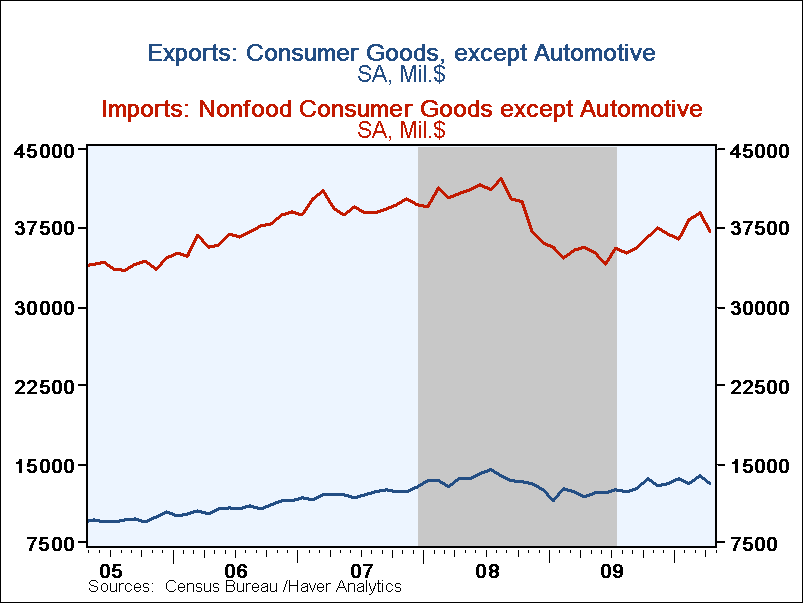 Global| Jun 10 2010
Global| Jun 10 2010U.S. Trade Deficit Stable M/M But Sharply Deeper Since Last Year
by:Tom Moeller
|in:Economy in Brief
Summary
The latest and revised U.S. foreign trade figures paint the same picture as earlier. An April deficit of $40.3B, stable since February, followed deterioration from its shallowest last May. The latest figure roughly matched Consensus [...]
The latest and revised U.S. foreign trade figures paint the same picture as earlier. An April deficit of $40.3B, stable since February, followed deterioration from its shallowest last May. The latest figure roughly matched Consensus expectations for a deficit of $41.0B.
The deficit's deterioration since last year reflects the U.S. economic recovery. Non-oil imports slipped 0.7% in April but it was the first monthly decline in nearly one year. The 21.1% y/y gain during the last twelve months reflects a two-thirds increase in imports of automotive vehicles & parts. Real nonauto consumer goods imports rose 4.0% y/y while capital goods imports jumped by nearly one-quarter with the strength in business investment. Finally, services imports have risen 6.8% y/y. U.S. travels abroad fell 0.7% y/y while passenger fares surged 15.0% y/y. "Other" transportation services imports jumped 7.7% y/y. Imports of petroleum products slipped marginally in April but were up by two-thirds from last year with the surge in prices.
Nominal exports slipped 0.7% during April following their slightly-revised 3.8% jump during March. Year-to-year, however, exports have risen a strong 19.9% with the dollar's lower value. The monthly dip reflected a 5.3% drop in nonauto consumer goods exports (+10.3% y/y) and a 7.6% drop in food & beverages (+4.2% y/y). These were offset by a 1.9% increase (50.3% y/y) in industrial supplies exports and a 1.4% gain (+57.2% y/y) in autos. In addition, exports of services rose 0.2% (8.0% y/y) as passenger fares were strong.
By country, the trade deficit with mainland China deepened to $19.3B, its deepest since December. Trade with China surged as exports jumped by one-quarter y/y and imports rose by a lesser 18.2%. The trade deficit with Japan eased to $4.8B but imports rose by roughly one-third y/y with the U.S. economic recovery and exports rose 17.2% y/y. With the European Union the trade deficit eased to $5.7B as exports rose 7.0% y/y and imports rose about the same.
The international trade data can be found in Haver's USECON database. Detailed figures are available in the USINT database.
| Foreign Trade | April | March | February | Y/Y | 2009 | 2008 | 2007 |
|---|---|---|---|---|---|---|---|
| U.S. Trade Deficit | $40.3B | $40.0B | $40.1B | $28.4B(4/09) | $378.6B | $695.9B | $701.4B |
| Exports - Goods & Services (m/m) | -0.7% | 3.8% | -0.1% | 19.9% | -14.6% | 11.5% | 13.2% |
| Imports - Goods & Services | -0.4 | 2.9 | 2.8 | 23.9 | -23.3 | 8.0 | 6.0 |
| Petroleum | -0.0 | 6.0 | 7.4 | 67.5 | -44.0 | 37.0 | 9.4 |
| Nonpetroleum Goods | -0.7 | 3.2 | 1.9 | 21.1 | -20.9 | 1.5 | 4.8 |
Tom Moeller
AuthorMore in Author Profile »Prior to joining Haver Analytics in 2000, Mr. Moeller worked as the Economist at Chancellor Capital Management from 1985 to 1999. There, he developed comprehensive economic forecasts and interpreted economic data for equity and fixed income portfolio managers. Also at Chancellor, Mr. Moeller worked as an equity analyst and was responsible for researching and rating companies in the economically sensitive automobile and housing industries for investment in Chancellor’s equity portfolio. Prior to joining Chancellor, Mr. Moeller was an Economist at Citibank from 1979 to 1984. He also analyzed pricing behavior in the metals industry for the Council on Wage and Price Stability in Washington, D.C. In 1999, Mr. Moeller received the award for most accurate forecast from the Forecasters' Club of New York. From 1990 to 1992 he was President of the New York Association for Business Economists. Mr. Moeller earned an M.B.A. in Finance from Fordham University, where he graduated in 1987. He holds a Bachelor of Arts in Economics from George Washington University.










